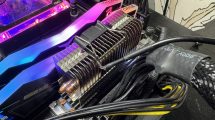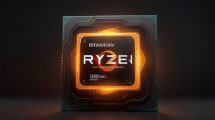

Yes, so for a good read- time: The Ryzen Threadripper 1950X has a whopping 16 cores, or 32 threads, 2 TB of addressable memory (which you couldn't even theoretically use in the absence of suitable 256 GB modules), ... Since it is difficult to get a pronounced server CPU for gaming optimally fit, AMD has provided in the Ryzen Master Tool a so-called game mode, which should help the Ryzen Threadripper to offer more performance in the current games. En... The AI test of Civilization VI is not a prime example of the Ryzen threadripper. Only the combination of overclocking and game mode (but only then) surpasses at least the Core i7-7820X.
In the VRMark you can find the hierachia between the ... Frames per second
Clock goes before core count, whereby the subtleties in detail again matter. Average and minimum FPS values are not everything. Nevertheless, all Ryzen Threadripper perform quite acceptable.
The FPS history as a cure... Frames per second
Clock again precedes core count, a typical symptom especially for older DX11 titles or Games whose engines don't really scale well with the number of possible threads.
The FPS history as curves over the entire ru... Frames per second
Why aren't we surprised? Clock is again (almost) everything, so that even the performance of the overclocked CPUs does not really surprise us. However, we refer to our detailed lists below, because also ... Frames per second
Hitman (2106) is an Intel domain, which hasn't changed with Ryzen Threadripper. The differences in this benchmark are really serious. Despite or just because of DirectX12? The fact is, however, that from approx. 140 FPS about... Frames per second
The stronger CPUs are not so far apart in the end, which may also be due to the fact that the graphics card already starts to limit easily. However, despite the higher clock speed, the Ryzen Threadripper 1920X can not... Frames per second
All CPUs are at a similarly high level, but there are differences.
The FPS history as curves over the entire run looks like this when comparing all CPUs:
Total Listing: Frame Times, Variance... Frames per second
All CPUs are almost the same, which of course is also due to the graphics card. However, it also shows very nicely that you don't always have to have the thickest CPU to swim with older titles at the top. ... Frames per second
Clock goes over core count and Intel dominates AMD. The differences are sometimes really serious.
The FPS history as curves over the entire run looks like this when comparing all CPUs:
Total listing: Frame Times, Va... Frames per second
Clock goes over core count and Intel dominates AMD again - it's a similar image to Project Cars. The differences are mainly found in the Frame Times and their variances, but also the more detailed consideration of the... Frames per second
We'll again forgo the game's slightly crashed DX12 mode and prefer to measure with the IX11 implementation. No matter which rendering path, AMD must beat the Intel CPUs in all variants. That doesn't mean it... Frames per second
At first glance, the differences are rather marginal, because even with Ultra-HD, graphics-side limitations already occur. Nevertheless, it has above all the frame time and its variances in itself. Clock goes before Kerna... Important preliminary remark on CPU selection and overclocking
Contrary to our usual handling, not benchmarking the productive areas with overclocked CPUs, as it is also rather unlikely in reality, this time we have both Ryze... 2D Performance
In order to better understand some of the later results, we are putting forward a good old acquaintance. With our GDI/GDI+ benchmark, we are first testing two different output methods for 2D objects, how to... CPU Performance: Workstation
Of course, in the production area, not only the 3D graphics performance is important in the production area for the just-set applications, because many things are calculated by the CPU in parallel within these applications (Simu... For these test series, we use benchmarks from the rather versatile SPECwpc suite for workstations, which rely on very different mathematical calculations, which on the one hand can be perfectly parallelized and where it is at the same time a... The right cooling is important!
One thing in advance: AMD dispenses with thermal paste between Die and IHS at the Ryzen Threadripper, but relies on the good old lot. This will open up completely new perspectives for us later on in the case of overclocking. En... Introduction
We determine the performance values of the package in a special sensor loop, i.e. exactly the value for what is absorbed by the CPU in terms of power and then almost completely returned to the cooling system as heat. Surely it would be unfair and hateful if AMD were simply to be assumed, as with the Vega Frontier Edition, that everything that does not make it to the top positions in gaming is simply as productive hardware for the so-called prosumer (o...
Since it is difficult to get a pronounced server CPU for gaming optimally fit, AMD has provided in the Ryzen Master Tool a so-called game mode, which should help the Ryzen Threadripper to offer more performance in the current games. Because let's be honest, with so many cores hardly any of the current titles scales, not to mention the older ones. But the type of storage access, which of course needs to be significantly different for large workloads, is also the subject of AMD's internal one-click optimization.
Normally, AMD relies on UMA (Distributed Mode) for Infinity Fabric and the combination of multiple Dies, but also offers NUMA (Local Mode). But what exactly is the difference for gamers or workstation users? In THE case of Uniform Memory Access (UMA), all of these use a global memory that can be accessed uniformly by all. As a final consequence, access times and latency are very similar, no matter where content is accessed from.
By NUMA (Non-Uniform Memory Access) we mean a special memory architecture in which each one that initially uses a kind of local memory, but still grants the others direct access to it via a common address space. The respective memory access times are then subject to the fact that a memory address is in the local or foreign memory. Ideally, it can be done much faster than global storage, but it doesn't have to.
In total, you have four different options via switch:
• Two active Dies and UMA
• Two active Dies and NUMA
• An active Die and UMA
• An active Die and NUMA
The Creator Mode relies on two Dies and UMA (Default), the Game Mode uses only one active Die and NUMA
We have therefore tested many of the variants that we consider interesting for the most interesting single benchmarks in advance with the Ryzen Threadripper 1950X and 1920X once against each other and want to precede these results as an introduction and the the most important possibilities later also in the comparison benchmarks, which we have divided into game and later workstation benchmarks.
As a resolution, we chose Full HD with 1920 x 1080 pixels with intent and due to the time available. First, it is the most common resolution, secondly, you get into possible CPU limits with a fast graphics card and thirdly, the benchmarking in Ultra-HD is quite nice, but the limitation of the graphics card is actually interested in such an article. Anyone.
UMA vs. NUMA vs. SMT and One-Click Gaming Mode
The ideal case, as AMD certainly imagined, is shown by the benchmark of Warhammer 40K. Here the game fashion can convince fully, at least for the time being.
The next examples show, however, that game fashion does not have to be the last resort of wisdom. Sometimes switching the memory to local mode (NUMA) is enough to be faster than prefabricated gaming fashion.
But while the Min-FPS are even closer together, the next example shows how the playability and subjective sensation can also be more clearly influenced by these memory variants:
Finally, let's look at the super-GAU, which AMD probably doesn't imagine. The Creator Mode (BIOS Default) is only surpassed by the strongly overclocked variant in game mode and the other variants with the memory in local mode (NUMA) are significantly behind. Now it has to be said that AotS scales pretty well over the cores and just parallelizable tasks across the Die borders benefit more from the UMA access management.

































Kommentieren